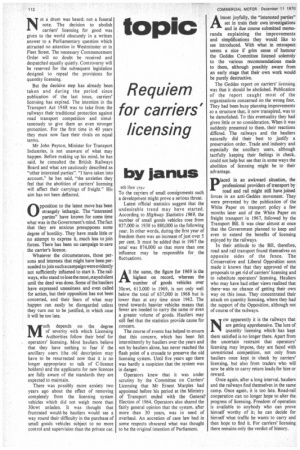Requiem for carriers' licensing
Page 114

If you've noticed an error in this article please click here to report it so we can fix it.
by Janus
Ott Haw rOv
To the carriers of small consignments such a development might prove a serious threat.
Latest official statistics suggest that the undesirable trend may have started. According to Highway Statistics 1969, the number of small goods vehicles rose from 837,000 in 1938 to 880,000 in the following year. In other words, during the first year of freedom there was an increase of just over 5 per cent. It must be added that in 1967 the totalwas 874,000 so that more than one influence may be responsible for the fluctuations.
11 the same, the figure for 1969 is the highest on record, whereas the
number of goods vehicles over 30cwt, 613,000 in 1969, is not only well below the total of 637,000 in 1968 but is lower than at any time since 1962. The trend towards heavier vehicles means that fewer are needed to carry the same or even a greater volume of goods. Hauliers may still feel that the statistics provide cause for concern.
The course of events has helped to ensure that this concern, which has been felt intermittently by hauliers over the years and not by hauliers alone, has never reached the flash point of a crusade to preserve the old licensing system. Until five years ago there was hardly a suspicion that the system was in danger.
Operators knew that it was under scrutiny by the Committee on Carriers' Licensing that Mr Ernest Marples had appointed before his period at the Ministry of Transport ended with the General' Election of 1964. Operators also shared the fairly general opinion that the system, after more than 30 years, was in need of overhaul. An accretion of case law had in some respects o,bscured what was thought to be the original intention of Parliament.
Almost joyfully, the "interested parties" set in train their own investigations and in due course submitted memoranda explaining the improvements and simplifications they would hie to see introduced. With what in retrospect seems a nice if grim sense of humour the Geddes Committee listened solemnly to the various recommendations made to them, although possibly aware from an early stage that their own work would be purely destructive.
The Geddes report on carriers' licensing was that it should be abolished. Publication of the report caught most of the organizations concerned 6n the wrong foot. They had been busy planning improvements .to a structure that, it now transpired, was to be demolished. To this eventuality they had given little or no consideration. When it was suddenly presented to them, their reactions differed. The railways and the hauliers naturally did their best to justify a preservation order. Trade and industry and especially the ancillary users, although tactfully keeping their feelings in check, could not help but see that in some ways the abolition of licensing might be to their advantage.
laced in an awkward situation, the professional providers of transport by road and rail might still have joined forces in an anti-Geddes movement. They were prevented by the publication of the White Paper on transport policy a few months later and of the White Paper on freight transport in 1967, followed by the Transport Bill. It was clear almost at once that the Government planned to keep and even to extend the benefits of licensing enjoyed by the railways.
In their attitude to the Bill, therefore, road and rail transport found themselves on opposite sides of the fence. The Conservative and Liberal Opposition soon made it known that they approved of the proposals to get rid of carriers' licensing and to substitute operators' licensing. Hauliers who may have had other views realized that there•was no chance of getting their own way on this issue. They concentrated their attack on quantity licensing, where they had the support of the Opposition, although not of course of the railways.
Now apparently it is the railways that are getting apprehensive. The lure of quantity licensing which .has kept them satisfied is no longer there. Apart from the uncertain restraint that operators' licensing may impose, they are faced with unrestricted competition, not only from hauliers once kept in check by carriers' licensing, but also from traders who will now be able to carry return loads for hire or reward.
Once again, after a long interval, hauliers and the railways find themselves in the same camp. Once again, it is too late. Road-rail cooperation can no longer hope to alter the progress of licensing. Freedom of operation is available to anybody who can prove himself worthy of it; he can decide for himself what traffic he wants to carry and then hope to find it. for carriers' licensing there remains only the verdict of history.






























































































































































